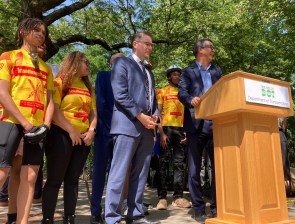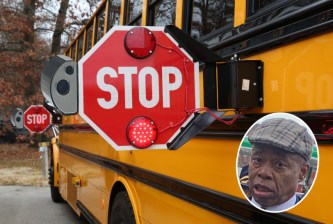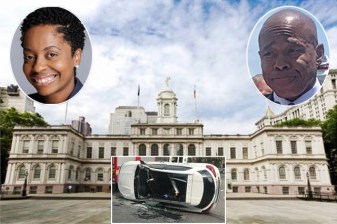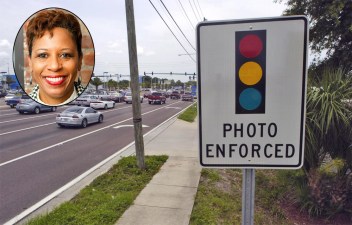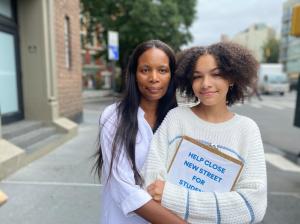Mayor Adams on Dangerous School Streets: ‘We Need to Do More’
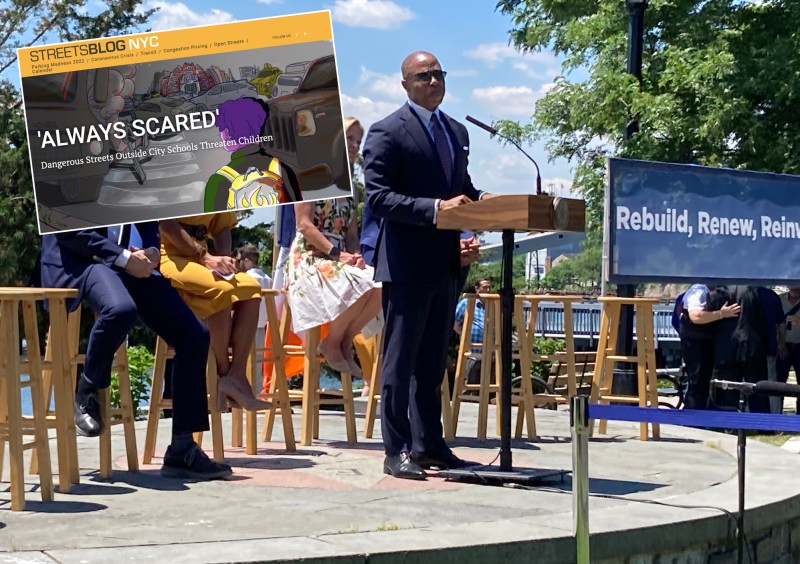
Mayor Adams said Wednesday that the city must take further steps to prevent drivers from hitting and injuring school children — the mayor’s first public comments on a Streetsblog report that revealed high levels of traffic violence around schools, especially those serving students of color.
“We need to do more,” Adams said when asked about Streetsblog’s findings at an unrelated news conference in the Bronx. “I’m going to look at that report, see what streets we’re talking about, and zero in on those streets.”

Adams joined a chorus of lawmakers and advocates calling for city action following Streetsblog’s investigation, which showed that rates of car crashes and injuries are far higher near schools than in the rest of the city, especially around schools where most students are poor or children of color. Department of Transportation Commissioner Ydanis Rodriguez offered a similar pledge to do more days after Streetsblog’s report and then announced a slew of new street safety projects outside city schools.
Adams was short on specifics about what he thinks the city should do to better protect children outside schools. But he touted some projects already under way: the city’s plan to retrofit 1,000 dangerous intersections, the state legislature’s expansion of the school-zone speed camera program, a safe driving advertising blitz and efforts to educate children about street safety.
But the mayor did not close the door on new city initiatives to tamp down on traffic violence around schools, saying he was open to ideas.
“If there are ideas that you have, that we should be doing … we listen to all great ideas,” Adams said. He added his administration is willing to “sit down and listen, and DOT commissioner will do so as well.”
Advocates say the best way to prevent drivers from causing mayhem near schools is simply to prevent them from getting near schools in the first place. Pedestrian-and-bike-only streets are common around schools in cities throughout the world, but New York rarely closes school streets to car traffic.
“When you remove cars, especially the unfettered access of cars, it eliminates the threat, and it makes the conditions safer for our most vulnerable,” Danny Harris, executive director of Transportation Alternatives, told Streetsblog recently. “The question really is whether our leaders are going to prioritize the lives of our kids over the movement and storage of cars.”
City Council members earlier this month called on the city to hire more crossing guards, install more traffic-calming features around schools and close more school streets to car traffic, among other measures.
Streetsblog’s investigation into school street safety revealed:
- On school days, streets near schools are more dangerous on average than other city streets. During the 8 a.m. hour, when hundreds of thousands of children stream into 1,600 city-run public schools, there are 57 percent more crashes and 25 percent more injuries per mile on streets near schools than on the city’s other streets.
- Streets are especially dangerous outside schools where most students are poor or children of color. In the 2019 school year, for example, the rate of people injured by drivers on school days was 43 percent higher outside school buildings where a majority of students were brown or Black than outside school buildings with majority-white students.
- Drivers crash nearly 50 times and injure a dozen people near city public schools during the average day when schools are open. That’s a crash every 29 minutes and an injury every two hours. The chaos peaks during the hours when children arrive at school in the morning and leave in the afternoon. At those times, there is a crash near a school every 17 minutes and an injury every 72 minutes.
- Drivers have killed at least 24 children heading to or from school on foot or bike in New York City in the past decade.
- DOT typically makes only modest changes to the design of unsafe school streets — too modest to make much difference, according to current and former DOT officials.
- The NYPD has left its ranks of school crossing guards chronically understaffed, and the guards that are employed face dangerous work conditions for rock-bottom pay.
When asked Wednesday for his thoughts about the demographic disparity in school street safety, Adams acknowledged that “poorer communities … have historically been denied the same level of street redesign.”

